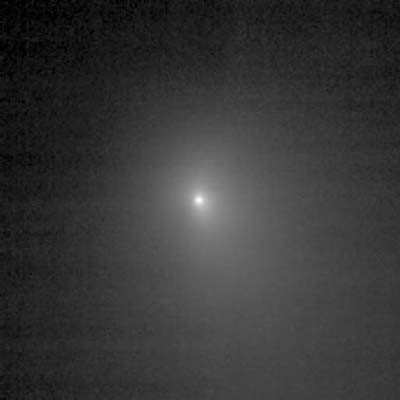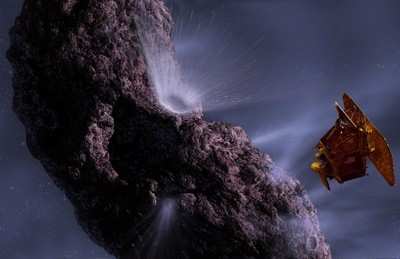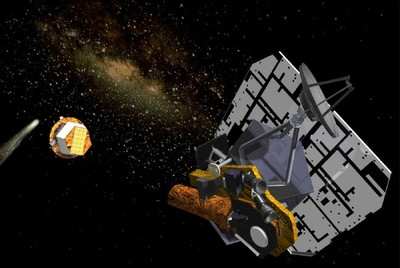Gazundheit!
NASA's Deep Impact spacecraft observed a massive, short-lived
outburst of ice or other particles from comet Tempel 1 that
temporarily expanded the size and reflectivity of the cloud of dust
and gas (coma) that surrounds the comet nucleus.

The outburst was detected as a dramatic brightening of the comet
on June 22. It is the second of two such events observed in the
past two weeks. A smaller outburst also was seen on June 14 by Deep
Impact, the Hubble Space Telescope and by ground based
observers.
"This most recent outburst was six times larger than the one
observed on June 14, but the ejected material dissipated almost
entirely within about a half day," said University of Maryland
College Park astronomer Michael A'Hearn, principal investigator for
the Deep Impact mission. A'Hearn noted that data from the
spectrometer aboard the spacecraft showed that during the June 22
outburst the amount of water vapor in the coma doubled, while the
amount of other gases, including carbon dioxide, increased even
more.
"Outbursts such as this may be a very common phenomenon on many
comets, but they are rarely observed in sufficient detail to
understand them because it is normally so difficult to obtain
enough time on telescopes to discover such phenomena," A'Hearn
said. "We likely would have missed this exciting event, except that
we are now getting almost continuous coverage of the comet with the
spacecraft's imaging and spectroscopy instruments."
Deep Impact co-investigator Jessica Sunshine, with Science
Applications International Corporation, Chantilly, Va., agreed that
observing such activity twice in two weeks suggests outbursts are
fairly common. "We must now consider them as a significant part of
the processing that occur on comets as they heat up when
approaching the sun," she said.

Comet Tempel 1 is near perihelion, or the point in its orbit at
which it is closest to the Sun.
"This adds to the level of excitement as we come down to the
final days before encounter," said Rick Grammier, Deep Impact
project manager at NASA's Jet Propulsion Laboratory, Pasadena,
Calif. "But this comet outburst will require no modification to
mission plan and in no way affects spacecraft safety."
Deep Impact consists of a sub-compact-car-sized flyby spacecraft
and an impactor spacecraft about the size of a washing machine. The
dual spacecraft carries three imaging instruments, two on the flyby
spacecraft and one on the impactor. A spectrometer on the flyby
spacecraft uses the same telescope as the flyby's high-resolution
imager.
The final prelude to impact will begin early on July 3, 24 hours
before the 1:52 a.m. EDT July 4th impact, when the flyby spacecraft
releases the impactor into the path of the comet. Like a copper
penny pitched up into the air just in front of a speeding
tractor-trailer truck, the 820-pound impactor will be run down by
the comet, colliding with the nucleus at a closing speed of 23,000
miles per hour. Scientists expect the impact to create a crater
several hundred feet in size; ejecting ice, dust and gas from the
crater and revealing pristine material beneath. The impact will
have no significant affect on the orbit of Tempel 1, which poses no
threat to Earth.

Nearby, Deep Impact's "flyby" spacecraft will use its medium and
high resolution imagers and infrared spectrometer to collect and
send to Earth pictures and spectra of the event. The Hubble and
Spitzer Space Telescopes, the Chandra X-ray Observatory, and large
and small telescopes on Earth also will observe the impact and its
aftermath.
 NTSB Prelim: Piper PA-23
NTSB Prelim: Piper PA-23 ANN FAQ: Submit a News Story!
ANN FAQ: Submit a News Story! Classic Aero-TV: One Mans Vietnam
Classic Aero-TV: One Mans Vietnam ANN's Daily Aero-Linx (07.03.25)
ANN's Daily Aero-Linx (07.03.25) ANN's Daily Aero-Term (07.03.25): High Speed Taxiway
ANN's Daily Aero-Term (07.03.25): High Speed Taxiway





